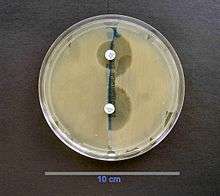Plasmid-mediated resistance

Plasmid-mediated resistance is the transfer of antimicrobial-resistant coding genes which are carried on plasmids. The plasmids can be transferred between prokaryotes through horizontal gene transfer. The spread of multiple antimicrobial resistance has been enhanced by selective pressure from human and veterinary medicine.[1]
ESBL Enterbacteriaceae

Plasmid encoded beta-lactamase is responsible for the emergence of resistant strains of Enterobacteriaceae. These enzymes are collectively termed as extended spectrum beta lactamases (ESBL).
They are especially problematic because strains that produce them may appear to be susceptible to the third generation cephalosporins but are in fact resistant to these antibiotics.These beta-lactamases degrade all the beta-lactam antibiotics except carbapenems and sometimes beta-lactam/beta-lactamase inhibitor combinations (e.g.-Piperacillin/Tazobactam.)
In addition, since the plasmids that carry ESBL genes also commonly encode resistance determinants for many other antibiotics, ESBL strains are often resistant to many non-beta-lactam antibiotics as well [2]
NDM-1
The enzyme which conferred resistance to beta-lactam as well as non beta-lactam antibiotics in the enterbacteriaceae bacteria among the UK patients was named as New Delhi metallo-beta-lactamase 1 (NDM-1) based on the assumption that the genetically encoded plasmids that conferred resistance to these bacteria originated in India and Pakistan.[3] However, various types of beta lactamases that conferred resistance to carbapenems and beta-lactam antibiotics like cephalosporins had already been reported in Canada, USA, Australia, Sweden and in the UK.,[4][5]
References
- ↑ Carattoli A (October 2003). "Plasmid-mediated antimicrobial resistance in Salmonella enterica" (PDF). Curr Issues Mol Biol. 5 (4): 113–22. PMID 12921226. Retrieved 2010-09-13.
- ↑ Broad spectrum antibiotics and resistance in non-target bacteria: an example from tetracycline, Journal of Pure and Applied Microbiology, (2014); 8(4): 2667-2671.
- ↑ Emergence of a new antibiotic resistance mechanism in India, Pakistan, and the UK: a molecular, biological, and epidemiological study, The Lancet Infectious Diseases, Early Online Publication, 11 August 2010 doi:10.1016/S1473-3099(10)70143-2
- ↑ http://www.biomerieux-diagnostics.com/servlet/srt/bio/clinical-diagnostics/dynPage?node=NDM1_2
- ↑ http://www.amplelife.org/html/viewnews.php?nid=105
Further reading
- Strahilevitz J, Jacoby GA, Hooper DC, Robicsek A (October 2009). "Plasmid-mediated quinolone resistance: a multifaceted threat". Clin. Microbiol. Rev. 22 (4): 664–89. doi:10.1128/CMR.00016-09. PMC 2772364
 . PMID 19822894. Retrieved 2010-09-13.
. PMID 19822894. Retrieved 2010-09-13. - Nordmann P, Poirel L (September 2005). "Emergence of plasmid-mediated resistance to quinolones in Enterobacteriaceae". J. Antimicrob. Chemother. 56 (3): 463–9. doi:10.1093/jac/dki245. PMID 16020539. Retrieved 2010-09-13.
- Oktem IM, Gulay Z, Bicmen M, Gur D (January 2008). "qnrA prevalence in extended-spectrum beta-lactamase-positive Enterobacteriaceae isolates from Turkey". Jpn. J. Infect. Dis. 61 (1): 13–7. PMID 18219128. Retrieved 2010-09-13.
- Chen LP, Cai XW, Wang XR, et al. (August 2010). "Characterization of plasmid-mediated lincosamide resistance in a field isolate of Haemophilus parasuis". J Antimicrob Chemother. 65 (10): 2256–2258. doi:10.1093/jac/dkq304. PMID 20699244. Retrieved 2010-09-13.